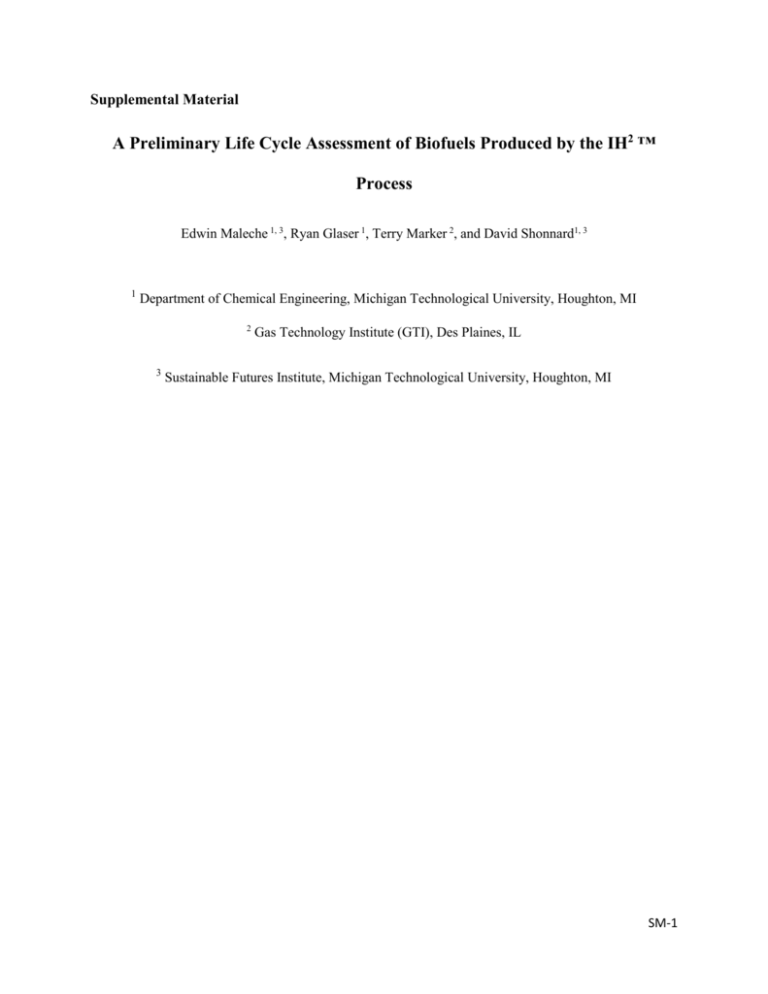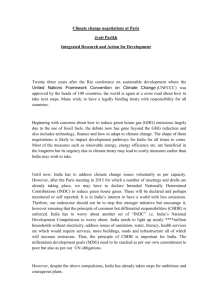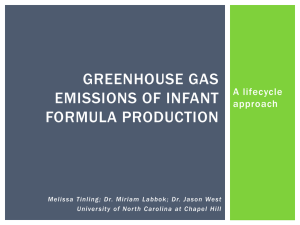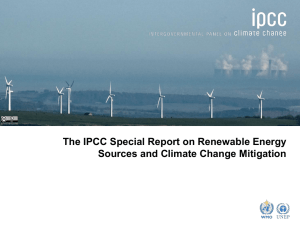ep11773-sup-0001-suppinfo
advertisement

Supplemental Material A Preliminary Life Cycle Assessment of Biofuels Produced by the IH2 ™ Process Edwin Maleche 1, 3, Ryan Glaser 1, Terry Marker 2, and David Shonnard1, 3 1 Department of Chemical Engineering, Michigan Technological University, Houghton, MI 2 3 Gas Technology Institute (GTI), Des Plaines, IL Sustainable Futures Institute, Michigan Technological University, Houghton, MI SM-1 Timber Resource Production Figure SM1 shown below illustrates how the percentages of hardwoods and softwoods changed with increasing plant size. Within the supply area, hardwoods comprise approximately 70% and softwoods 30% of the available feedstock. The higher percentage of hardwood at the smaller plant sizes is the result of low valued hardwood residues available from an adjacent pulp and paper mill (Park Falls, WI). As plant size increases, forest resources further from the proposed IH2 plant are accessed, depending on total cost, including stumpage, harvest, and transportation. For this study, plant sizes of 500 dry short tons/day and 1,000 dry short tons/day of feedstock were selected for evaluation in the model. Figure SM2 shows the distribution of total diesel fuel among feedstock collection, transportation, and processing (chipping). Above 1,000 dry short tons/day, there is not much change in total diesel consumption per dry short ton (costs decrease for collection at the same rate with respect to changes in plant size as transport costs increase). Therefore, in this study we use the 1,000 dry short tons/day fuel use data. total hardwoods total softwoods 25 125 225 325 425 525 625 725 825 925 1,025 1,125 1,225 1,325 1,425 1,525 1,625 1,725 100% 90% 80% 70% 60% % 50% 40% 30% 20% 10% 0% Plant Size in Bone Dry Short Tons/Day Figure SM1. The percentages of hard wood and soft wood used as the feedstock input with varying plant size. SM-2 collection trucking processing Gallons of Fuel / short ton 3.00 2.50 2.00 1.50 1.00 0.50 25 125 225 325 425 525 625 725 825 925 1,025 1,125 1,225 1,325 1,425 1,525 1,625 1,725 0.00 Plant Size in Bone Dry Short Tons/Day Figure SM2. Diesel fuel consumption for collection, trucking, and processing as a function of biomass input rate Energy Allocation Factors (EAF) The EA factor was applied to all inputs in every life cycle stage to the IH2 biofuels production system. Energy allocation is an energy balance around the IH2 process where co-products are produced. We wish to know what fraction of total output of energy from the process is contained in IH2 biofuels. Energy can be carried out of the process in various forms; IH2 biofuels, steam, and char co-product. As a quality check on these energy balance calculations, we also attempted to balance the total input energy from the input biomass to the IH2 conversion process, with all output energy streams. Our attempts to do this from the data provided by GTI yielded energy balances that did not close perfectly, but the output energy was lower than the input energy by 5-20% for most feedstocks. Although this is not perfect data quality, such a result is consistent with energy losses from the process in the form of waste heat which was not SM-3 quantified. In summary, we feel that the data quality was of sufficiently high quality to proceed with the final analyses. The (EA) factor was obtained by using the equations below whereby the denominator represents the total energy out from all products and numerator is energy content of the IH2 gasoline and IH2diesel. The Microalgae IH2 Biofuels When the individual inputs are included the above equation transforms into; 𝑔𝑎𝑠𝑜𝑙𝑖𝑛𝑒 𝐸𝐴𝐹 = 𝑑𝑖𝑒𝑠𝑒𝑙 ⏞ 𝑀𝐽 ⏞ 𝑀𝐽 𝑘𝑔 𝑘𝑔 (44 𝑘𝑔 ∗ 4.48 × 105 𝑑𝑎𝑦) + (44 𝑘𝑔 ∗ 4.48 × 105 𝑑𝑎𝑦) 𝑀𝐽 𝑘𝑔 𝑀𝐽 𝑘𝑔 (44 𝑘𝑔 ∗ 4.48 × 105 𝑑𝑎𝑦) + (44 𝑘𝑔 ∗ 4.48 × 105 𝑑𝑎𝑦) ⏟ ⏟ 𝑔𝑎𝑠𝑜𝑙𝑖𝑛𝑒 =1 𝑑𝑖𝑒𝑠𝑒𝑙 Bagasse IH2 Biofuels 20% moisture content bagasse with char as a product 𝐸𝐴𝐹 𝑔𝑎𝑠𝑜𝑙𝑖𝑛𝑒 𝑑𝑖𝑒𝑠𝑒𝑙 ⏞ 𝑀𝐽 (44 ∗ 432981.82 = 𝑘𝑔 𝑀𝐽 𝑘𝑔 𝑀𝐽 𝑘𝑔 𝑑𝑎𝑦 ⏞ 𝑀𝐽 ) + (44 ∗ 140318.18 𝑘𝑔 𝑀𝐽 𝑘𝑔 𝑘𝑔 𝑑𝑎𝑦 𝑘𝑔 ) 𝑀𝐽 𝑘𝑔 (44 ∗ 432981.82 ) + (44 ∗ 140318.18 ) + (26.8 ∗ 334759 ) (1.9845 ∗ 313985 ) 𝑑𝑎𝑦 𝑑𝑎𝑦 𝑘𝑔𝑐ℎ𝑎𝑟 𝑑𝑎𝑦 ⏟ 𝑘𝑔𝑠𝑡𝑒𝑎𝑚 𝑑𝑎𝑦 ⏟ 𝑘𝑔 ⏟ 𝑘𝑔 ⏟ 𝑔𝑎𝑠𝑜𝑙𝑖𝑛𝑒 𝑑𝑖𝑒𝑠𝑒𝑙 𝑐ℎ𝑎𝑟 𝑠𝑡𝑒𝑎𝑚 = 0.724 20% moisture content bagasse with char burned 𝑔𝑎𝑠𝑜𝑙𝑖𝑛𝑒 𝐸𝐴𝐹 = 𝑑𝑖𝑒𝑠𝑒𝑙 ⏞ 𝑀𝐽 ⏞ 𝑀𝐽 𝑘𝑔 𝑘𝑔 (44 𝑘𝑔 ∗ 432981.82 𝑑𝑎𝑦) + (44 𝑘𝑔 ∗ 140318.18 𝑑𝑎𝑦) 𝑀𝐽 𝑘𝑔 𝑀𝐽 𝑘𝑔 𝑀𝐽 𝑘𝑔 (44 𝑘𝑔 ∗ 432981.82 𝑑𝑎𝑦) + (44 𝑘𝑔 ∗ 140318.18 𝑑𝑎𝑦) + (1.9845 𝑘𝑔𝑠𝑡𝑒𝑎𝑚 ∗ 1465964 𝑑𝑎𝑦) ⏟ ⏟ ⏟ 𝑔𝑎𝑠𝑜𝑙𝑖𝑛𝑒 𝑑𝑖𝑒𝑠𝑒𝑙 = 0.897 𝑠𝑡𝑒𝑎𝑚 SM-4 Corn Stover IH2 Biofuels 20% moisture content corn stover with char burned 𝑔𝑎𝑠𝑜𝑙𝑖𝑛𝑒 𝐸𝐴𝐹 = 𝑑𝑖𝑒𝑠𝑒𝑙 ⏞ 𝑀𝐽 ⏞ 𝑀𝐽 𝑘𝑔 𝑘𝑔 (44 𝑘𝑔 ∗ 320 × 103 𝑑𝑎𝑦) + (44 𝑘𝑔 ∗ 200 × 103 𝑑𝑎𝑦) 𝑀𝐽 𝑘𝑔 𝑀𝐽 𝑘𝑔 𝑀𝐽 𝑘𝑔 (44 ∗ 320 × 103 ) + (44 ∗ 200 × 103 ) + (1.98 ∗ 3.734 × 106 ) 𝑑𝑎𝑦 𝑑𝑎𝑦 𝑘𝑔𝑠𝑡𝑒𝑎𝑚 𝑑𝑎𝑦 ⏟ 𝑘𝑔 ⏟ 𝑘𝑔 ⏟ 𝑔𝑎𝑠𝑜𝑙𝑖𝑛𝑒 𝑑𝑖𝑒𝑠𝑒𝑙 = 0.755 𝑠𝑡𝑒𝑎𝑚 Forest Resources IH2 Biofuels For the two different feedstock moisture scenarios, the energy allocation factor equations are as seen in the equations below. The Low Heating Value of the hydrogen was obtained from literature (Grohmann et al. 1984), while the LHV for the wood biomass was obtained from other literature. 30%moisture feedstock 𝑔𝑎𝑠𝑜𝑙𝑖𝑛𝑒 𝑑𝑖𝑒𝑠𝑒𝑙 ⏞ 𝑀𝐽 (44 ∗ 3.2 × 105 𝐸𝐴𝐹 = 𝑘𝑔 𝑀𝐽 𝑘𝑔 𝑘𝑔 )+ 𝑑𝑎𝑦 𝑀𝐽 (44 𝑘𝑔 ∗ 3.2 × 105 𝑑𝑎𝑦) + (44 𝑘𝑔 ∗ 1.99 × ⏟ ⏟ 𝑔𝑎𝑠𝑜𝑙𝑖𝑛𝑒 ⏞ 𝑀𝐽 (44 ∗ 1.99 × 105 𝑘𝑔 𝑘𝑔 5 10 𝑑𝑎𝑦) + 𝑘𝑔 ) 𝑑𝑎𝑦 𝑀𝐽 (1.9845 𝑘𝑔𝑠𝑡𝑒𝑎𝑚 ⏟ 𝑑𝑖𝑒𝑠𝑒𝑙 𝑘𝑔 ∗ 2.92 × 105 𝑑𝑎𝑦) = 0.798 𝑠𝑡𝑒𝑎𝑚 Life Cycle Impact Assessment per MJ IH2 Biofuels 5.1 Microalgae IH2 Biofuel The results from the analysis were arrived at by dividing the 1-day impact results by the total energy content of the IH2 biofuels produced (39,424,000 MJ/day), or multiplying by the reciprocal which was 2.54x10-8 of a day/MJ. This calculation is shown in equations below. 1 + 𝐼𝐻 2 𝑑𝑖𝑒𝑠𝑒𝑙 𝐼𝐻 2 𝑔𝑎𝑠𝑜𝑙𝑖𝑛𝑒 SM-5 1 = 2.54𝐸 − 8 𝑑𝑎𝑦/𝑀𝐽 (19,712,000 𝑀𝐽/𝑑𝑎𝑦) + (19,712,000 𝑀𝐽/𝑑𝑎𝑦) Doing this converted the GHG emissions from a 1 day basis to 1 MJ IH2 biofuel basis. 5.2 Bagasse IH2 Biofuels The results from the analysis were arrived at by dividing the 1-day impact results by the total energy content of the IH2 biofuels produced (25,225,200 MJ/day), or multiplying by the reciprocal which was 3.96 x10-8 of a day/MJ. This calculation is shown equations below. 1 + 𝐼𝐻 2 𝑑𝑖𝑒𝑠𝑒𝑙 𝐼𝐻 2 𝑔𝑎𝑠𝑜𝑙𝑖𝑛𝑒 1 = 3.96𝐸 − 8 𝑑𝑎𝑦/𝑀𝐽 (19,051,200 𝑀𝐽/𝑑𝑎𝑦) + (6,174,000 𝑀𝐽/𝑑𝑎𝑦) Doing this converted the GHG emissions from a 1 day basis to 1 MJ IH2 biofuel basis. A comparison of the GHG results for IH2 biofuels is compared to the life cycle GHG emission for petroleum gasoline, diesel, and aviation fuel. 5.3 Corn Stover IH2 Biofuels The results from the analysis were arrived at by dividing the 1-day impact results by the total energy content of the IH2 biofuels produced (22,880,000 MJ/day), or multiplying by the reciprocal which was 4.37 x10-8 day/MJ. This calculation is shown equations below. 1 + 𝐼𝐻 2 𝑑𝑖𝑒𝑠𝑒𝑙 𝐼𝐻 2 𝑔𝑎𝑠𝑜𝑙𝑖𝑛𝑒 1 = 4.37𝐸 − 8 𝑑𝑎𝑦/𝑀𝐽 (14,080,000 𝑀𝐽/𝑑𝑎𝑦) + (8,800,000 𝑀𝐽/𝑑𝑎𝑦) SM-6 5.4 Forest Feedstocks IH2 Biofuels The results from the analysis were arrived at by dividing the 1-day impact results by the total energy content of the IH2 biofuels produced (22,880,000 MJ/day), or multiplying by the reciprocal which was 4.37 x10-8 day/MJ. This calculation is shown equations below. 1 𝐼𝐻 2 𝑔𝑎𝑠𝑜𝑙𝑖𝑛𝑒 + 𝐼𝐻 2 𝑑𝑖𝑒𝑠𝑒𝑙 1 = 4.37𝐸 − 8 𝑑𝑎𝑦/𝑀𝐽 (14,080,000 𝑀𝐽/𝑑𝑎𝑦) + (8,800,000 𝑀𝐽/𝑑𝑎𝑦) Microalgae Biomass Production Greenhouse gas emissions for production of microalgae are shown in Table SM1 based on different electricity generation assumptions. The highest emissions are from the use of coal electricity, intermediate emissions include US grid average or natural gas electricity, and the lowest emissions are from renewable electricity. Considering the inputs for microalgae from Table 1 of the main article, the emissions are highest for the motors in the Pump Shed section, followed by De-watering, road transport, and New Harvest Units. Table SM1 Effect of Electricity Type (Primary Energy) on GHG Emissions of Algae Algae Production Electricity Type Coal US Grid Average Natural Gas Geothermal Biomass Nuclear Wind Hydro GHG Emissions (kg CO2 eq. / dry mt algae) 1030 657 656 286 258 236 235 231 SM-7 Corn Stover Biomass Production The main categories of the corn stover production system which are considered for the LCA analysis were i. fertilizer replacement, ii. cornstover collection, iii. cornstover transportation, and iv. cornstover loading and loading. Table SM2 shows the greenhouse gas emissions per dry metric ton of fertilizer replacement, collection, loading, unloading and transported to a IH2 unit over a distance of 30 mi. The total GHG emissions are 66.8 kg CO2 eq. per dry metric ton corn stover biomass. The largest contributor to this total is the fertilizer replacement, followed by collection, transport, and loading/unloading. Table SM2 Corn Stover Production and Transport GHG Emissions Corn Stover Production Stages Stover Collection Fertilizer Replacement Stover Road Transport Stover Loading Total GHG Emissions (kg CO2 eq. / dry mt stover) 12.1 42.5 5.4 5.3 65.3 Bagasse Biomass Production The main categories of the bagasse handling which are considered for the LCA analysis were i) bagasse transportation ii) bagasse loading and unloading, and iii) bagasse energy. In Table SM3 are shown the greenhouse gas emissions per dry metric ton for loading, unloading, and transportation to a IH2 unit 100 km (62 mi.) distance from the sugarcane milling factory. The total GHG emissions are 27.1 kg CO2 eq. per dry metric ton bagasse. The largest contributor to this total is transportation, which is equivalent to 24.40 kg CO2 eq. per dry metric ton, and the next is the loading and unloading of the bagasse which is only 2.65 kg CO2 eq. per dry metric ton. Table SM3 Bagasse Production and Transport GHG Emissions Forest Resource Production Stages Loading and Unloading Road Transport Total GHG Emissions (kg CO2 eq. / dry mt bagasse) 2.7 24.4 27.1 SM-8 Forest Resources Production The GHG results in Table SM4 are grouped into three main sections: collection, transportation and yard preprocessing. The largest source if GHG emission is electricity consumed for size reduction of the forest biomass. Diesel fuel for biomass collection is the next largest, followed by diesel fuel for transportation. Table SM4 Forest Biomass Production and Transport GHG Emissions Forest Resource Production Stages Collection Road Transport Yard Processing (sizing) Total GHG Emissions (kg CO2 eq. / dry mt) 18.6 14.1 26.4 59.2 Scenario Analysis: Electricity Generation Primary Energy Type The effects of electricity generation type on GHG emissions of algae IH2 biofuels are shown in Table SM5. Table SM5 Effect of Electricity Type (Primary Energy) on GHG Emissions of Algae IH2 Biofuel Algae Production Electricity Type Coal US Grid Average Hydro GHG Emissions (g CO2 eq. / MJ of IH2 fuel) 83.9 63.6 39.3 SM-9 References Grohmann K, Himmel M, Rivard C, Tucker M, Baker J, Torget R, Graboski M. 1984. "Sixth Symposium on Biotechnology for Fuels and Chemicals", Biotechnology. Bioengineering. Symposium., 14, 137. SM-10







